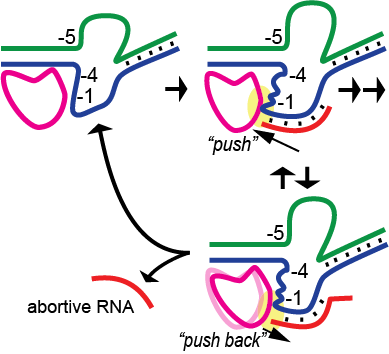New Insights into the Mechanism of Initial Transcription: the T7 RNA Polymerase Mutant P266L Transitions to Elongation at Longer RNA Lengths than Wild Type
Luis Ramírez-Tapia & Craig T. Martin, J. Biol. Chem. 287, 37352-37361, 2012.

RNA polymerases undergo substantial structural and functional changes in transitioning from sequence-specific initial transcription to stable and relatively sequence-independent elongation. Initially transcribing complexes are characteristically unstable, yielding short abortive products on the path to elongation. However, protein mutations have been isolated in RNA polymerases that dramatically reduce abortive instability. Understanding these mutations is essential to understanding the energetics of initial transcription and promoter clearance. We demonstrate here that the P266L point mutation in T7 RNA polymerase, which shows dramatically reduced abortive cycling, also transitions to elongation later, i.e., at longer lengths of RNA. These two properties of the mutant are not necessarily coupled, but rather we propose that they both derive from a weakening of the barrier to RNA-DNA hybrid-driven rotation of the promoter binding N-terminal platform, a motion necessary to achieve programmatically timed release of promoter contacts in the transition to elongation. Parallels in the multi-subunit RNA polymerases are discussed.
PMID: 22923611 PMCID: PMC3481332 DOI: 10.1074/jbc.M112.370643